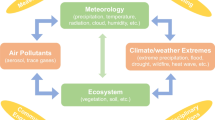Abstract
In this study, the land–sea breeze circulation model coupled with a random-walk model is developed by the analysis of the formation and the mechanism of the land–sea breeze. Based on the data of the land–sea circulation in Dalian, China, the model simulated the diurnal variation of pressure, flow, temperature, and turbulent kinetic energy field and also provides a basis for solving the air pollutant concentration in the land–sea breeze circulation so as to estimate the economic cost attributable to the atmospheric pollution. The air pollutant concentration in the background of land–sea circulation is also simulated by a Gaussian dispersion model, and the results revealed that the land–sea circulation model coupled with the random-walk model gives a reasonable description of air pollutant dispersion in coastal areas.
Similar content being viewed by others
References
Baerentsen, J. H., & Berkowicz, Z. (1984). Monte Carlo simulation of plume dispersion in the convective boundary layer. Atmospheric Environment, 18, 701–712.
Boybeyi, Z., Sethu, R., & Zannetti, P. (1995). Numerical investigation of possible role of local meteorology in Bhopal gas accident. Atmospheric Environment, 29(4), 479–496.
Deardor, J. W., & Willis, G. E. (1982). Ground-level concentrations due to fumigation into an entraining mixed layer. Atmospheric environment, 16, 1159–1170.
Degrazia, G. A., Carvalho, J. C., Moreira, D. M., Vilhena, M. T., Roberti, D. R., & Magalhaes, S. G. (2007). Derivation of a decorrelation timescale depending on source distance for inhomogeneous turbulence in a convective boundary layer. Physica A, 374, 55–65.
Famulari, D., Fowler, D., Nemitz, E., Hargreaves, K. J., et al. (2008). Development of a low-cost system for measuring conditional time-averaged gradients of SO2 and NH3. Environmental Monitoring and Assessment, 161, 11–27.
Graziani, G., Martilli, A., Pareschi, M. T. B., & Valenza, M. (1997). Atmospheric dispersion of natural gases at Vulcano island. Journal of Volcanology and Geothermal Research, 75, 283–308.
Hanna, S. R., & Drivas, P. J. (1987). Guidelines for use of vapor clouds dispersion models, New York, centre for chemical process safety (p. 177). New York, NY: American Society of Chemical Engineers.
Hurley, P., & Physick, W. (1991). A Lagrangian particle model of fumigation by break down of the nocturnal inversion. Atmospheric Environment, 25(7), 1313–1325.
Kassomenos, P. A., Flocas, H. A., Lykoudis, S., & Skouloudis, A. (1998). Spatial and temporal characteristics of the relationship between air quality status and mesoscale circulation over an urban Mediterranean basin. The Science of the Total Environment, 217, 37–57.
Kouchi, A., Ohba, R., & Shao, Y. (1999). Gas diffusion in a convection layer near a coastal region. Journal of Wind Engineering and Industrial Aerodynamics, 81, 171–180.
Louis, J. F. (1979). A parametric model of vertical eddy fluxes in the atmosphere. Boundary-Layer Meteorology, 17, 187–202.
Lu, R., & Turco, R. P. (1994). Air pollutant transport in a coastal environment. Part I: Two-dimensional simulations of sea-breeze and mountain effects. Journal of the Atmospheric Sciences, 51(5), 2285–2308.
Luhar, A., & Sawford, B. L. (1995). An examination of existing shoreline fumigation models and formulation of an improved model. Atmospheric Environment, 30, 609–620.
Lyons, W. A., & Cole, H. S. (1973). Fumigation and plume trapping on the shores of Lake Michigan during stable onshore flow. Journal of Applied Meteorology, 12, 495–510.
McNider, R. T. (1981). Investigation of the impact of tropospheric circulations on the transport and dispersion of air pollutants. Ph.D. dissertation, Department of Environmental Sciences, University of Virginia, Charlottesville.
McNider, R. T., Moran, M. D., & Pielke, R. A. (1998). Influence of diurnal and inertial boundary layer oscillation on long-range dispersion. Atmospheric Environment, 22, 2445–2462.
Oza, R. B., Panchal, N. S., Nambi, K. S. V., & Krishnamoorthy, T. M. (2001). Coupling of mesoscale meteorological model with particle trajectory model to study the atmospheric dispersion under sea breeze conditions. Environmental Modelling & Software, 16, 63–71.
Pielke, R. A., Cotton, R., Walko, R. L., Tremback, C. J., Lyons, W. A., Grasso, L. D., et al. (1992). A comprehensive meteorological modeling system—RAMS. Meteorology and Atmospheric Physics, 49, 69–91.
Pitts, R. O., & Lyons, T. J. (1992). A coupled mesoscale and particle model applied to an urban area. Atmospheric Environment, 26B, 279–289.
Rodriguez, D. J., Greenly, G. D., Gresho, P. M., Lange, R., Lawver, B. S., Lawson, L. A., et al. (1986). User’s guide to the MATHEW/ADPIC models. Livermore, CA: Lawrence Livermore National Laboratory, University of California.
Shao, Y. (1992). Turbulent dispersion in coastal atmospheric boundary layers: An application of Lagrangian model. Boundary-Layer Meteorology, 59, 363–385.
Shao, Y., Hacker, J. M., & Schwerdtfeger, P. (1991). The structure of turbulence in a coastal atmospheric boundary layer. Quarterly Journal of the Royal Meteorological Society, 117, 1299–1324.
Tremback, C. J., & Kessler, R. (1985). A surface temperature and moisture parametrization for use in mesoscale numerical model. In Presented in the 7th conference on numerical weather prediction (pp. 17–20). Montreal, Canada.
Triantafyllou, A. G., & Kassomenos, P. A. (2002). Aspects of atmospheric flow and dispersion of air pollutants in a mountainous basin. Science of the Total Environment, 297, 85–103.
Tripoli, G. J., & Cotton, W. (1986). An intense, quasi-steady thunderstorm over mountainous terrain. Part IV: Three-dimensional numerical simulation. Journal of the Atmospheric Sciences, 43, 896–914.
Yamazawa, H. (1989). Performance examination of atmospheric model at sea-coast region. Journal of Nuclear Science and Technology, 26(4), 459–472.
Yassin, M. F., Ohba, M., & Tanaka, H. (2008). Experimental study on flow and gaseous diffusion behind an isolated building. Environmental Monitoring and Assessment, 147, 149–158.
Author information
Authors and Affiliations
Corresponding author
Rights and permissions
About this article
Cite this article
Wang, P., Mu, H. Random-walk model simulation of air pollutant dispersion in atmospheric boundary layer in China. Environ Monit Assess 172, 507–515 (2011). https://doi.org/10.1007/s10661-010-1350-6
Received:
Accepted:
Published:
Issue Date:
DOI: https://doi.org/10.1007/s10661-010-1350-6




